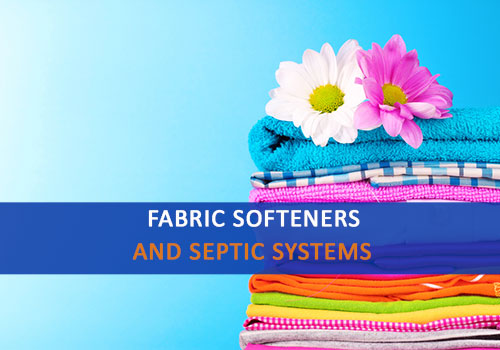When most people think about septic systems, they think about their bathrooms. They may think about the signs asking folks not to flush anything but paper.
But, what about fabric softeners and septic tanks?
It’s probably not on the forefront of septic owners’ minds; after all, septic systems process waste. What does your laundry have to do with it?
Quite a lot! Even though septic systems are designed to treat human waste, all of your household water goes through the system as well, including the water used for laundry. And with delicate, natural bacteria doing much of the heavy lifting to treat your waste, it’s essential to keep them healthy. But, harsh chemicals can easily knock off that balance — including those found in fabric softeners.

How Do Fabric Softeners Work?
We all love putting on a soft shirt or pants; it’s one of the lives most simple pleasures. But, how do softeners keep our clothes so soft, even after multiple washes?
It’s thru chemicals. Fabric softeners added to the wash cycle (like liquids or beads) form a small chemical protective layer activated during the drying cycle. They are also oil-based (are you starting to see an alarming trend here?).
Additionally, many softeners contain ammonium compounds — an antibacterial. The chemicals, oil, and antibacterial properties don’t play nice with the necessary bacteria in your septic system.
What Happens if the Bacteria in Your Tank Stop Working?
The bacteria in your septic tank are a critical piece of the waste treatment puzzle. When healthy, they munch on solid wastes, helping break them down into liquids and gases.
When they are healthy, they can decompose up to 50% of the waste in your septic tank.
But, if they aren’t healthy, it leads to several issues. With the solid waste not being broken down efficiently, over time, you’ll begin to see:
- Backups into your home – gross!
- More frequent need for septic tank pump-outs – money down the drain!
- Solid waste being forced into your drainfield – uh oh!
The bottom line? Fabric softeners and septic tanks don’t mix.
Fabric Softeners and Septic Tanks — the Solution
While you may need to find alternatives, having a septic system doesn’t mean the end of having soft clothes! There are a few alternatives you can explore in place of using liquid fabric softeners.
Vinegar is everyone’s friend! Vinegar has natural softening and odor-eliminating properties. Add a half-cup to your next wash. Are you missing that fresh scent? Add a few drops of your favorite essential oil into the mix.
Use fabric softeners sheets during the dry cycle. While they work the same way, by the time your clothes make it back into the wash cycle, some of the chemicals have been worn off.
If you absolutely cannot put the liquid fabric softener down, explore “septic safe” softeners. While most still contain chemicals, they are less concentrated than many of the name brands. Keep an eye out for non-petroleum-based products as those will not have the oil-base, cutting out one of the septic tank irritants.
Keeping Your Septic Tank Healthy (and Wallet Full)
A happy septic tank is an efficient septic tank and one that doesn’t require costly repairs. In addition to avoiding fabric softeners, here are a few other tips for keeping your septic healthy.
- Flush only toilet paper — no “flushable wipes,” feminine hygiene products, diapers, paper towels, medicine, etc.
- Use the garbage disposal sparingly — your septic isn’t a trash can
- No grease or oil down the sink
- Do not overwater your drain field area — this makes it harder for the wastewater to get its final treatment
- Follow your maintenance schedule, including a tank pump-out when needed
Fabric softeners and septic tanks don’t mix, but that doesn’t mean the end of your soft clothes. It’s all about finding a balance that keeps your septic system healthy and happy.
Need to schedule a septic system service or repair? Call Advanced Septic Services of Florida at 352-242-6100 — we happily service the Lake County and Central Florida Areas!

